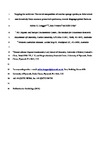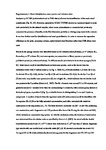Tapping the archives: The sterol composition of marine sponge species, as determined non-invasively from museum preserved specimens, reveals biogeographical features
| dc.contributor.author | Lengger, SK | en |
| dc.contributor.author | Fromont, J | en |
| dc.contributor.author | Grice, K | en |
| dc.date.accessioned | 2016-08-17T10:48:53Z | |
| dc.date.issued | 2016-12-15 | en |
| dc.identifier.uri | http://hdl.handle.net/10026.1/5322 | |
| dc.description.abstract |
Over 8600 species are currently recorded in the phylum Porifera (sponges). They produce a large diversity of biochemical compounds including sterols, with more than 250 different sterols identified. Some of these sterols are of great interest, due to their use for fingerprinting in ecological and biomarker (molecular fossil) studies. As a large number of identified extant species from biodiversity surveys are housed in museum collections, preserved in ethanol, these present a potentially rich source of identified specimens for comparative lipid analyses. Here, we show that, in at least one species, sterol distributions obtained from the ethanol used to preserve specimens of sponges were representative, and comparable to the sterol distribution obtained from wet-frozen and from freeze-dried tissue from the same species. We employed both GC-MS and two-dimensional gas chromatography-time-of-flight mass spectrometry (GC×GC-TOFMS), with an improved signal-to-noise ratio for even minor constituents. Analysis of two additional specimens of the same species, but of different provenance, resulted in detection of marked differences in sterol composition, which could be attributed to variations in geography, environmental conditions, microbial communities, diet or cryptic speciation. The possibility of using ethanol from identified, preserved museum sponges could drastically increase the number of available samples. This could enable the study of their sterol complements, and the detailed investigation of differences due to geographical and oceanographic, phylogenetic, and other factors in unprecedented detail. | |
| dc.language.iso | en | en |
| dc.title | Tapping the archives: The sterol composition of marine sponge species, as determined non-invasively from museum preserved specimens, reveals biogeographical features | en |
| dc.type | Journal Article | |
| plymouth.publication-status | Accepted | en |
| plymouth.journal | Geobiology | en |
| plymouth.organisational-group | /Plymouth | |
| plymouth.organisational-group | /Plymouth/Faculty of Science and Engineering | |
| plymouth.organisational-group | /Plymouth/REF 2021 Researchers by UoA | |
| plymouth.organisational-group | /Plymouth/REF 2021 Researchers by UoA/UoA07 Earth Systems and Environmental Sciences | |
| dcterms.dateAccepted | 2016-08-08 | en |
| dc.rights.embargodate | 2017-09-29 | en |
| dc.rights.embargoperiod | Not known | en |
| rioxxterms.licenseref.uri | http://www.rioxx.net/licenses/all-rights-reserved | en |
| rioxxterms.licenseref.startdate | 2016-12-15 | en |
| rioxxterms.type | Journal Article/Review | en |



